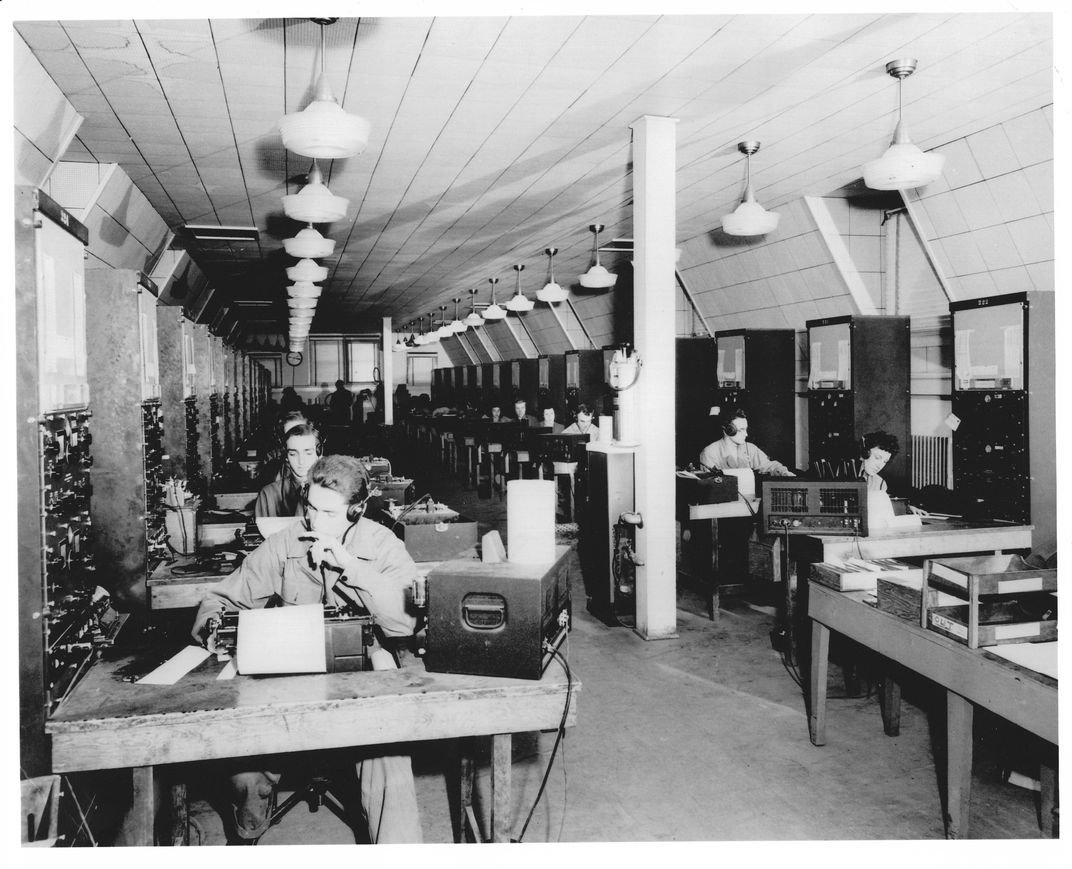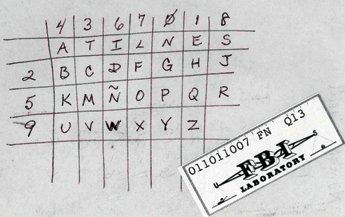
Vint Hill Craft Winery was transformed into a Signals and Intelligence spy station during World War II. Photo courtesy of the Smithsonian Institution/Cold War Museum
“The chair is against the wall” and “John has a long mustache” were two phrases repeated twice through a radio broadcast in the popular scene of the 1984 cult-classic “Red Dawn.” These phrases were inspired by the real broadcasts sent to bands of allied resistance fighters, including the Special Operations Executive (SOE), who heard the coded messages signaling the cancellation or final orders of a sabotage mission during World War II.
Radio stations throughout history, whether in secret or in disguise, were an effective means to communicate with spies, prisoners of war, or those on deep-cover assignments. On rare — though at times more frequent — occasions, radio transmissions near the Strait of Hormuz were not attempts of covert contact but the acts of small-minded tomfoolery by pranksters that call themselves the “Filipino Monkey.” Their mythical reputation for interrupting naval exercises, including one exchange between an Iranian warship and a passing cargo ship, are legendary. When the Iranian Captain asked what they were transporting, the Filipino Monkey bursted over the radio, “I am carrying machine guns and hand grenades to Iraq … and the atom bomb.”
Covert radio stations often lack an origin story and are unclaimed by government entities unless their identities are revealed in declassified documents decades later. Because the origin of these voices, signals, and frequencies broadcast to the world are unknown, listeners provided them with interesting names such as “The Swedish Rhapsody,” “Nancy Adam Susan,” and the most widely known, the Lincolnshire Poacher, which was assumed to be operated by MI6.
Spy Radio

While radio stations can reach a wide audience in a deniable area, spies also use mobile transmission devices such as shortwave radios. One of the most famous instances employing shortwave radios was in the case of Ana Montes, the former senior analyst of the Defense Intelligence Agency (DIA), who spied against the United States beginning in the 1980s. She was outed as a traitor and is considered one of the most damaging double agents in U.S. history. The then 44-year-old Cuban spy was smart, memorizing details from classified documents in her head. She’d then transfer the materials onto her laptop at home, copy them onto encrypted floppy discs, and arranged dead drops with her Cuban handlers.
The double agent tuned her Sony shortwave radio to AM frequency 7887 kHz and followed instructions spoken in Spanish. She used a one-time pad to decode the numbers into a message. Montes was DIA’s top analyst in Cuba, and for 17 years she deliberately informed Cuban intelligence with priceless and crippling information, including the presence of U.S. Army Special Forces in Latin America and the identities of American intelligence officers working in Cuba. Ten days after 9/11, she was arrested and sentenced to 25 years in prison.
The Buzzer (ZhUOZ MDZhB UZB76)
The Buzzer (ZhUOZ MDZhB UZB76) is an unclaimed radio station formerly located in a swampland near St. Petersburg, Russia. Tuned to radio frequency 4625 kHz, the station broadcasts a buzzing sound 24 hours a day and seven days a week since the 1970s. The monotonous buzzing sounds are interrupted once or twice a week by a man’s voice. Conspiracy theorists and radio enthusiasts hypothesize whether the radio station was once a Russian military communications center used to deliver messages to bases or field operatives under a monolit format — a codeword for the recipient, a 5-digit group, followed by another codeword.
Questions lacking answers speculate the origins of this relic of the Cold War and why the airwaves remain open, free to listen to at one’s own curiosity.
Wading River Radio Station

The Benson House, an unassuming three-story red Wading River home tucked away into the woods from outsiders in Long Island, was the spot where FBI agents and radio technicians lived in secret from 1942 to 1945. When a businessman from Spain was coerced by the Germans to work for the Abwehr, German intelligence, he contacted the FBI and soon became a double agent. The FBI hid a radio antenna somewhere in the woods on the 71-acre property, used an engine from a vehicle to disguise the suspicion of a generator, and set up a secret radio station on the upper two floors of the home.
The FBI broadcasted hundreds of accurate and misleading messages to German intelligence in Hamburg, who thought they were communicating with their own agents in the United States. In April 1942, German intelligence sent a message inquiring information about the atomic bomb. The FBI helped deceive the location of the D-Day invasion and misled Japanese forces in operations in the Pacific.
On the 70th anniversary of D-Day, the Society of Former Special Agents of the FBI emplaced a plaque to recognize the contributions from those involved in the secret operation. In 2014, the Benson House was registered on the National Register of Historic Places.
Colombia Morse Code Song
Colonel Jose Espejo watched the grainy video of a TV screen showing 16 Colombian soldiers chained inside a prisoner of war camp guarded by the Revolutionary Armed Forces of Colombia (FARC) deep in the jungle. Espejo, the communications expert of the Colombian army, phoned advertising executive Juan Carlos Ortiz in 2010 with a plan. Just two years prior, Espejo air-dropped 7 million pacifiers into FARC-controlled areas in an attempt to draw pregnant female guerrillas into defecting.
Risky commando missions were launched on similar camps located throughout the region, and Espejo needed to inform the prisoners of a possible rescue. Together, Espejo and Ortiz recruited musicians and military policemen familiar with Morse code to create a catchy pop song called “Better Days” by Natalia Gutierrez Y Angelo. The song was broadcast across 130 small radio stations reaching more than 3 million listeners. One, if not the only, luxury for the POWs was their access to shortwave radios. While the FARC rebels nodded along to the tune of “Better Days,” the POWs translated the Morse code hidden in the beat. After the lyric, “Listen to this message brother,” the coded message says, “19 people rescued. You’re next. Don’t lose hope.”

Matt Fratus is a history staff writer for Coffee or Die. He prides himself on uncovering the most fascinating tales of history by sharing them through any means of engaging storytelling. He writes for his micro-blog @LateNightHistory on Instagram, where he shares the story behind the image. He is also the host of the Late Night History podcast. When not writing about history, Matt enjoys volunteering for One More Wave and rooting for Boston sports teams.
BRCC and Bad Moon Print Press team up for an exclusive, limited-edition T-shirt design!
BRCC partners with Team Room Design for an exclusive T-shirt release!
Thirty Seconds Out has partnered with BRCC for an exclusive shirt design invoking the God of Winter.
Lucas O'Hara of Grizzly Forge has teamed up with BRCC for a badass, exclusive Shirt Club T-shirt design featuring his most popular knife and tiomahawk.
Coffee or Die sits down with one of the graphic designers behind Black Rifle Coffee's signature look and vibe.
Biden will award the Medal of Honor to a Vietnam War Army helicopter pilot who risked his life to save a reconnaissance team from almost certain death.
Ever wonder how much Jack Mandaville would f*ck sh*t up if he went back in time? The American Revolution didn't even see him coming.
A nearly 200-year-old West Point time capsule that at first appeared to yield little more than dust contains hidden treasure, the US Military Academy said.












